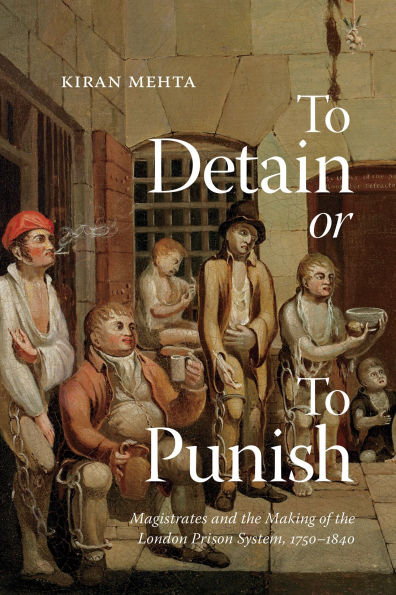Imprisonment was rarely used as punishment in Britain before 1800. The criminal justice system was based on terror and deterrence, sentencing convicts to the gallows at home and transportation overseas, with prisons serving primarily as holding spaces for the accused until the case against them was resolved. A major shift began in the late eighteenth century when imprisonment became an end in itself: a means to reform as well as to discipline criminal offenders.
To Detain or to Punish revisits this revolutionary moment as it played out in the metropolis of London. Kiran Mehta charts how Londoners, through their interactions with police, magistrates, and judges, became prisoners, and then follows them into the prison, revealing how these institutions were managed and experienced. Local authorities’ increased use of imprisonment, for punishment as well as for detention, sparked the wholesale reconstruction and redesign of London’s prison estate. It also spurred the consolidation of the modern notion that prisoners who had not yet been convicted of a crime, or who had not been sentenced to imprisonment, should be held separately from and treated differently to those incarcerated for punishment. Most notably, the requirement to labour became a distinguishing feature of punitive confinement.
Challenging traditional ideas about who and what prisons were for and how they operated, To Detain or to Punish offers a radical reappraisal of London’s prison system between 1750 and 1840.
Imprisonment was rarely used as punishment in Britain before 1800. The criminal justice system was based on terror and deterrence, sentencing convicts to the gallows at home and transportation overseas, with prisons serving primarily as holding spaces for the accused until the case against them was resolved. A major shift began in the late eighteenth century when imprisonment became an end in itself: a means to reform as well as to discipline criminal offenders.
To Detain or to Punish revisits this revolutionary moment as it played out in the metropolis of London. Kiran Mehta charts how Londoners, through their interactions with police, magistrates, and judges, became prisoners, and then follows them into the prison, revealing how these institutions were managed and experienced. Local authorities’ increased use of imprisonment, for punishment as well as for detention, sparked the wholesale reconstruction and redesign of London’s prison estate. It also spurred the consolidation of the modern notion that prisoners who had not yet been convicted of a crime, or who had not been sentenced to imprisonment, should be held separately from and treated differently to those incarcerated for punishment. Most notably, the requirement to labour became a distinguishing feature of punitive confinement.
Challenging traditional ideas about who and what prisons were for and how they operated, To Detain or to Punish offers a radical reappraisal of London’s prison system between 1750 and 1840.

To Detain or to Punish: Magistrates and the Making of the London Prison System, 1750-1840
306
To Detain or to Punish: Magistrates and the Making of the London Prison System, 1750-1840
306Related collections and offers

Product Details
| ISBN-13: | 9780228024101 |
|---|---|
| Publisher: | McGill-Queens University Press |
| Publication date: | 04/10/2025 |
| Series: | States, People, and the History of Social Change , #12 |
| Sold by: | Barnes & Noble |
| Format: | eBook |
| Pages: | 306 |
| File size: | 9 MB |
